If you have the opportunity to follow the romantic Perfume River, don’t miss the chance to stop and visit Sinh Hue Village. This is where the most famous folk paintings in the ancient land are created. Join DanangPrivate Car.com’s to learn about the lives deeply rooted in the generations of talented artists who create the Sinh Village paintings.
Table of Contents
Introduction to Sinh Hue Village
It is no coincidence that Sinh Hue Village is included in the list of the hottest tourist destinations in the former capital city. This traditional village has its roots dating back to the 15th century and is famous for its traditional folk paintings and festive events. The Sinh Hue paintings, with a history of over 500 years, are a cultural heritage that needs to be preserved for the nation.
Sinh Hue Village Address
Sinh Hue Village is a unique destination, unlike any other place on the Hue tourism map. It is located about 10 km from the city center. Sinh Hue Village is situated along the picturesque Perfume River.
Particularly, the village has a strategic position, where various branches of the river converge. It is the place where the Perfume River merges with the Bo River before flowing into the Tam Giang Estuary.

- Where is Sinh Hue Village located? Sinh Hue Village Address: Lại Ân Hamlet, Phú Mậu Commune, Hue City, Thừa Thiên Huế Province.
History and the name of Sinh Hue Village
Sinh Hue Village – The name that piques the curiosity of many tourists about its origins. The village, located on the banks of the Perfume River, has a quite distinctive name. In the Nom script, Sinh Hue Village is known as Lai An.
Since the 15th and 16th centuries, people from Hai Duong, Thanh Hoa, Nghe An, and Ha Tinh migrated here to explore new territories. When they arrived in present-day Thua Thien Hue province, they settled down and established Lại Ân Village.
This is one of the early villages in the Dang Trong region. In front of Lai An Village, facing it, is the ancient town of Bao Vinh Hue, once a famous river port.

The old Lai an Village (present-day Sinh Hue Village) used to be a renowned center of trade and culture, bustling with activity. The lively trading scene here has been praised in poetry, highlighting the beauty of the Kinh Ky region.
The scholar Duong Van An mentioned Lai An Village in his writing: “The Bao Vinh Bridge is filled with bustling horses and carriages, while Lai An Village resounds with the crowing of roosters, urging business travelers to compete for profits.” This vividly portrays the image of a bustling trading hub in the past.
Another poem also includes the lines: “Lại Ân Village, stir-frying chicken sounds, Prompting business travelers to buy ten for one.”
What traditional craft does Sinh Hue Village have?
Sinh Hue Village is known for its traditional folk painting craft. These are paintings primarily used for worshiping, serving religious and spiritual needs. Sometimes, the paintings are also used in ceremonies for blessings and removing obstacles.
There are about 50 themes in Sinh Hue paintings, mainly focusing on depicting social activities and ancient beliefs. Moreover, this ancient village is also famous for its festive events that attract visitors from all over the region. In addition to the painting craft, traditional trades in the village include making incense and popping popcorn.
Guide on how to get to Sinh Hue Village from the city center.
In Sinh Hue Village – a village known for its traditional painting craft, there are many intriguing things that will make you curious. And rest assured, the journey to explore this ancient village in the heart of the former capital city will become truly memorable.
Routes to Sinh Hue Village.
There are two ways to travel to Sinh Hue Village: by road or by water.
First method:
You can travel to Sinh Hue Village by waterway. Rowing a boat along the Perfume River in Hue for about 9 km, visitors will gradually see the serene village emerging in the southwest direction. Sinh Hue Village is located opposite the Perfume River.
Sitting on a boat and heading towards the village, you will have a peaceful and relaxing journey amidst the poetic water landscape. You can enjoy the scenery and feel the fresh air. This is a transportation method to the village that is particularly favored by international tourists and visitors from afar.
Second method:
Travel by car, motorbike, taxi, or other means of transportation along the road. From the center of Hue, drive along Nguyen Sinh Cung Street. When you reach No Market, turn left onto Road 2. This is the area of Sinh Hue Village.
Which transportation method should you choose to get to Sinh Hue Village?
Sinh Hue Village is relatively easy to navigate on the map and is located less than 10 km from the city center. Therefore, it takes visitors just over 15 minutes to travel here.
The route is flat, easy to find, and also easy to travel on. Therefore, you can choose any type of transportation that suits your preferences and conditions.
Based on travel experiences in Hue, young tourists often prefer to visit Sinh Hue Village by motorbike. Renting a motorbike for a price ranging from 100,000 to 120,000 VND per day allows you to freely explore various destinations in the city. Additionally, tourists can also book a taxi or car to get to Sinh Hue Village.
For foreign visitors who want to explore Sinh Hue Village, it is recommended to pre-arrange a private car in Hue to manage their time effectively. DanangPrivateCar.com is a leading car rental service provider in Hue, and you can make a reservation today to have the best trip.
Discovering Sinh Hue Village, when is the best time to go?
The dreamy city has a fairly mild and pleasant climate. However, during the autumn-winter season, from October to January, Hue often experiences heavy rainfall. These rains bring along cold weather and can last for consecutive weeks.
The heavy rain can make your trip more inconvenient. Therefore, the ideal seasons to explore the traditional painting village are spring and summer. From March to September is the most suitable time for a leisurely trip to Sinh Hue Village.
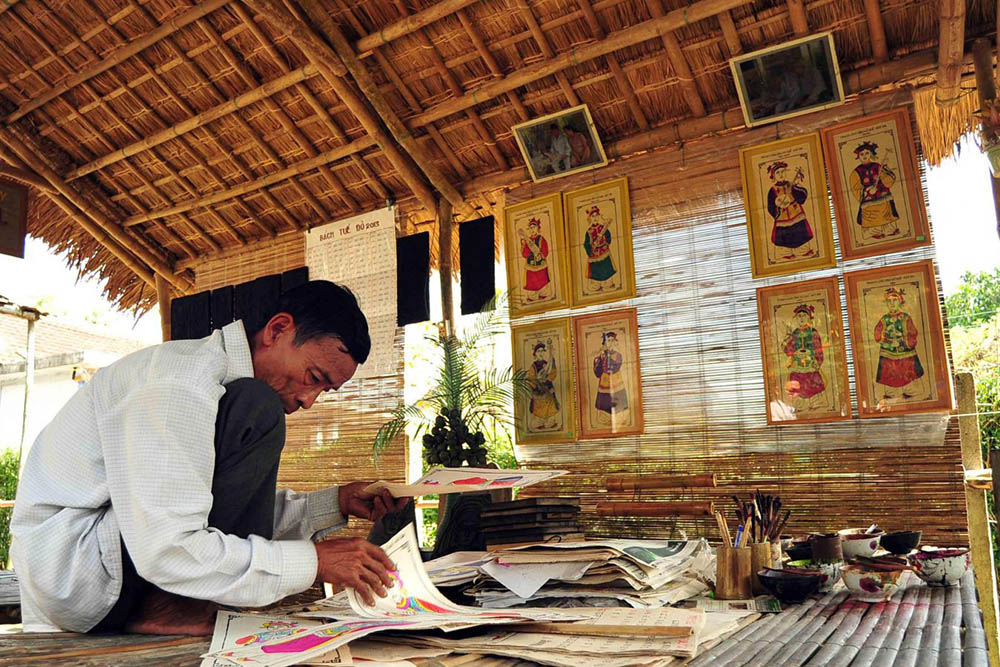
During this period, the weather is dry and rainfall is rare. You can easily travel to outdoor tourist destinations, including Sinh Hue Village. Especially, the sunny days also allow tourists to capture stunning “check-in” photos.
The scenery of the traditional painting village in the summer is incredibly serene. It all contributes to the peaceful beauty of the riverside village, completely separated from the hustle and bustle of the urban areas.
Learn about the famous Sinh Hue Village paintings, which have a history of over 400 years.
Follow Sơn Trà Travel to Sinh Village and discover the home of artist Kỳ Hữu Phước, the last person holding the secret of creating Sinh Hue Village paintings, to explore the unique characteristics of these paintings from their original form.
Since when has the traditional folk painting profession in Sinh Village existed?
Around the 15th century, during the Trinh-Nguyen period, a group of people migrated from the North and settled in the Thuan Hoa region. Among them was Mr. Kỳ Hữu Hòa. According to legends, he brought the craft of making traditional paper paintings from his homeland to this place.
As the people opened up new lands and established villages, they engaged in farming, fishing, and other traditional handicrafts to make a living. Among them, the painting profession helped the artist Kỳ Hữu Hòa achieve stable livelihood. Gradually, the art of painting developed strongly in Sinh Hue Village.
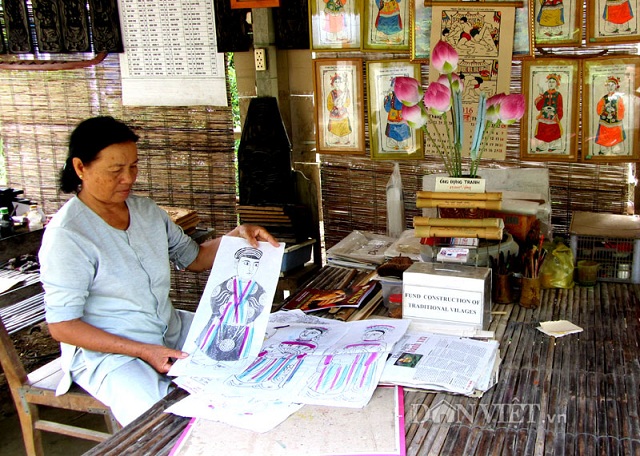
This was because the region had a rich cultural heritage with many folk beliefs, festivals, and ancestral worship customs. These included ceremonies such as Kỵ giỗ (ancestral anniversary), the “bất đắc kỳ tử” ceremony, grave cleaning rituals, and ancestral worship ceremonies on specific dates. There were also ceremonies like Lễ tiết, Lễ trai điếu bạt độ, thờ thần cửa ngõ, and Lễ cúng tiên sư.
The Sinh Village paintings had the opportunity to expand and develop in the long run. The painting profession spread and passed down from generation to generation. More and more people began to learn and make a living from this craft.
What makes Sinh Hue Village paintings special?
Sinh Hue Village paintings, also known as Lai An Village paintings, are individual prints on separate sheets of paper. The paintings are printed using wooden blocks. The blocks are carved from jackfruit, areca nut, or jackfruit wood, which helps create clear lines. After printing, the paintings are colored using hues derived entirely from natural materials.
Artist Ky Huu Phuoc is the only one remaining in Sinh Hue Village who holds all the secrets to creating an authentic Sinh Hue Village painting.

Having dedicated over 60 years to the painting profession in Sinh Hue Village, the artist stated, “These paintings were traditionally used for worshiping and serving ritual activities.”
Sinh Hue Village worship paintings are divided into three types as follows:
- Character paintings: Depicting figures such as Lady (Bà), Doctor (Ông Đốc), Dancing Master (Ông Điệu), and Kitchen Paper (Tờ bếp).
- Animal paintings: Featuring livestock and the 12 zodiac animals, serving the purpose of transforming offerings into gold for ancestors.
- Object paintings: Illustrating clothing, household utensils, bows and arrows, money, traditional attire for men and women, and military uniforms.
The process of creating a traditional painting from the village of Sinh Hue.
To create a complete painting from the village of Sình Huế, it requires going through 7 stages. This demands extreme meticulousness and dedication from the artists. Especially, they must have a love for the craft and a special passion.
Paper cutting.
The paper used to make Sinh Hue paintings is large-sized paper, similar to newspaper size. First, a specialized knife is used to cut the paper into various sizes (depending on the type of painting).

Materials and color mixing:
The paper used for the paintings is raw paper. In the past, people from the village of Sinh Hue had to go to Pha Tam Giang – Lang Co town to collect seashells. These seashells have various colors.
They would bring back beautiful seashells and grind the shells into powder, mixing them with glue. Then, they would apply this powder onto the paper. This is the process to create standard painting paper.
Brushing seashell powder.
The second stage, which also requires meticulousness, is brushing seashell powder. This stage is entirely done by hand. The brushes used for Siinh Hue paintings are made from wild pineapple trees.
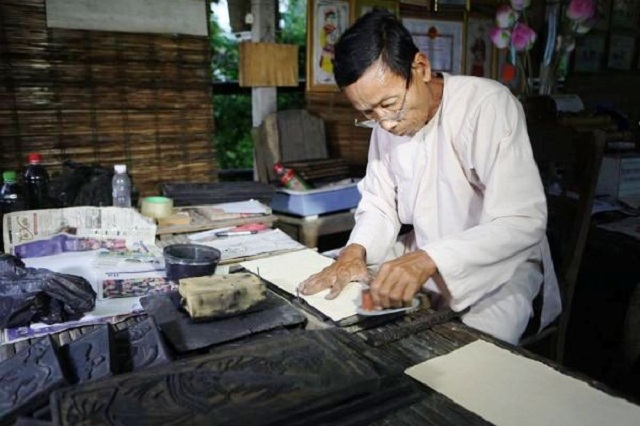
Printing on wooden blocks.
After the seashell powder has completely dried, the artists proceed to print the Sinh Hue paintings on wooden blocks. These wooden blocks are carved in advance with various shapes and sizes. At the house of the artist Ky Huu Phuoc, there are about 40-50 wooden blocks being used and displayed.
If a visitor wants to order a custom painting with a chosen theme, they can visit the artist in the village of Sinh Hue to select their favorite wooden block.

Alternatively, the artist Ky Huu Phuoc can carve a new wooden block. After preparing all the necessary materials, the artist places the wooden block on the ground.
Using a “phết” (made from coconut husk), they apply glue onto the wooden block. Then, they press the carved lines onto the block. Next, they layer the paper that has been brushed with seashell powder on top. Finally, they use a brush made from loofah fibers to evenly spread glue on the paper before removing it.
Drying the paintings.
The next stage in creating a Sinh Hue painting is drying. Nowadays, this part has become much simpler because the number of paintings to be created has significantly decreased.
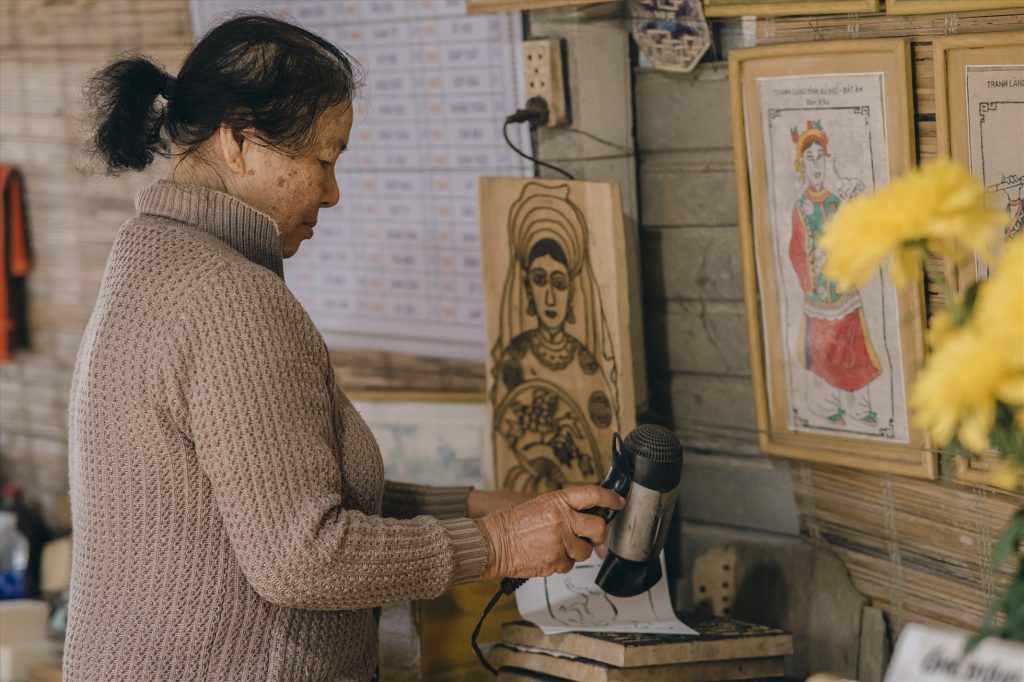
Kỳ Hữu Phước mentioned that he only makes a few paintings each day. Therefore, it is possible to dry the paintings right on the spot, saving time and effort. If there is a need to create a large quantity of Sinh Hue paintings or when the weather turns cold and there is rain or storms, this stage becomes more complex and challenging.
Mixing and applying colors to the paintings.
Mixing and applying colors is a stage that requires the artist’s skill and artistic talent. First, the artist mixes the colors. The process of mixing colors brings inspiration to visitors and viewers.
You will be amazed when you see the incredibly vibrant colors, processed from natural materials. One remarkable aspect is that Sinh Hue paintings never use industrial or chemical colors.

For example, purple color is made from ripe mollusk shells boiled in water. Yellow color is extracted from jackfruit leaves and trumpet tree flowers. Green color is mixed from mulberry and sweet cotton tree. Orange color is made from powdered bricks.
Even the brushes used to apply colors to Sinh Hue paintings are made from roots found by the roadside. After going through the meticulous process of color mixing, the artists use these brushes to apply colors to the paintings based on different themes.
The predominant colors in Sinh Hue paintings are bright and prominent, such as red, black, green, purple, and yellow. As DanangPrivateCar.com’s has introduced, the colors used for painting the Sinh Hue village paintings are derived from natural materials, such as seashells, young trumpet flowers, turmeric, ripe jackfruit seeds, water fern leaves, ash, etc.
Labeling
The final stage in the process of creating Sinh Hue village paintings, as introduced by DanangPrivateCar.com, is labeling the paintings.
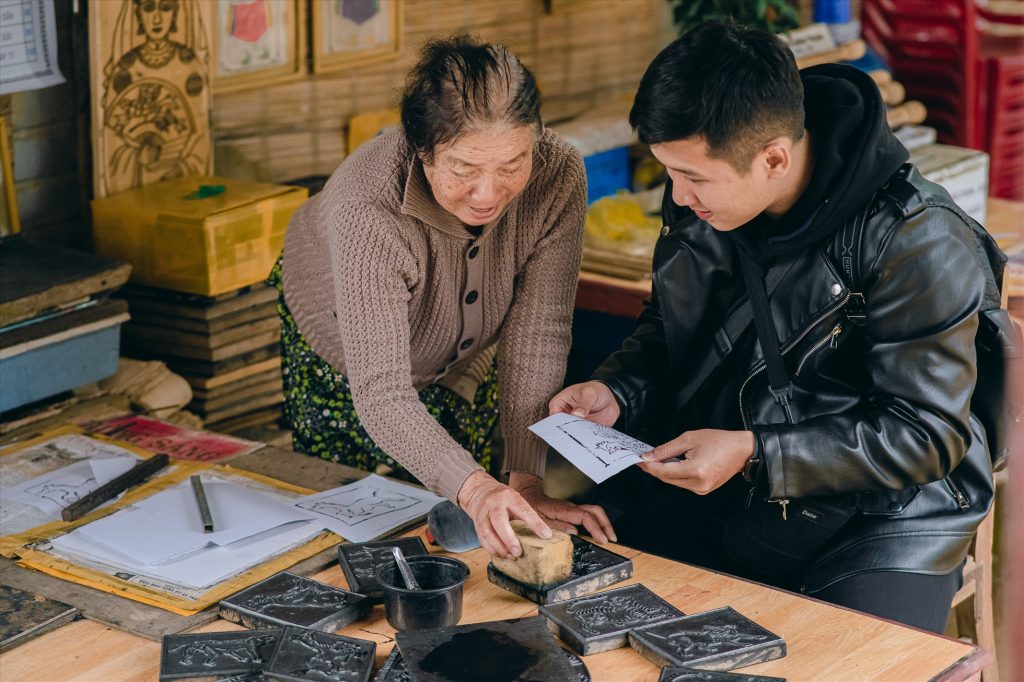
According to the sharing of the artist Ky Huu Phuoc, only a few painting themes that have been registered with the Department of Culture and Arts are allowed to be labeled.
What can you experience when visiting Sinh Hue village?
By reading up to this point, you can surely imagine the uniqueness and meticulousness involved in creating a Sinh Hue village painting. However, it’s best to directly visit this traditional painting village because there are still many exciting experiences awaiting visitors. Let’s follow DanangPrivateCar.com to Sinh Hue village!
Learn about the folk painting profession.
This is one of the oldest traditional craft villages in Hue. Therefore, the first experience for you when coming here is to explore the folk painting profession.
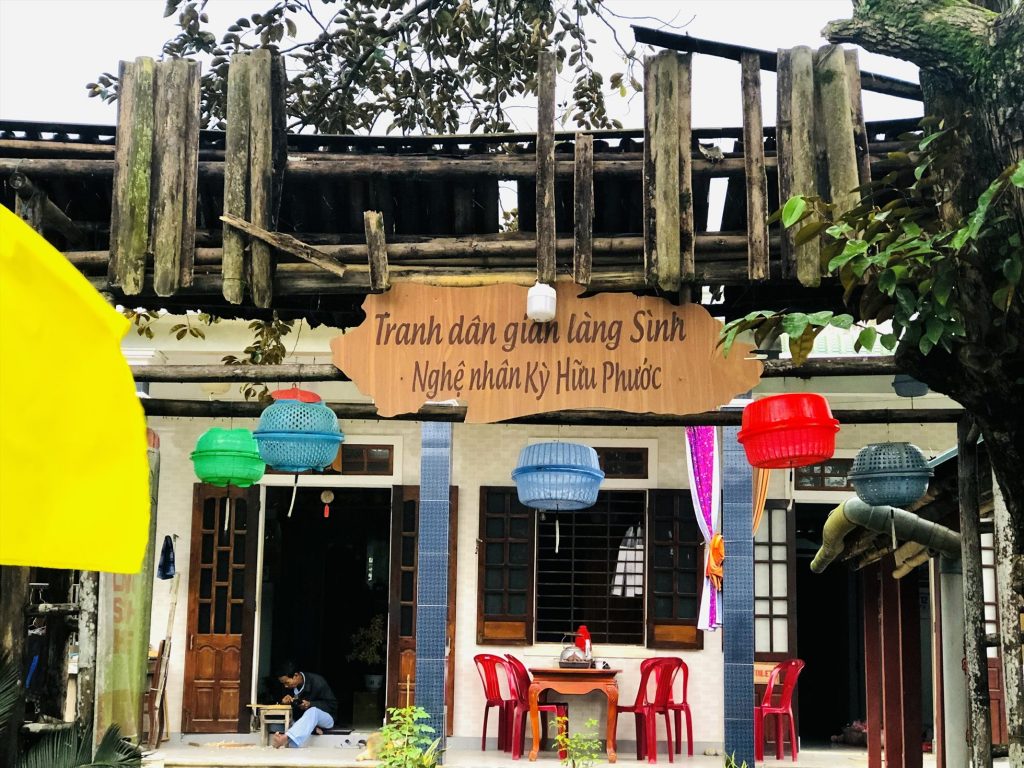
You will have the opportunity to learn about the characteristics of a painting through the storytelling of artist Kỳ Hữu Phước. He is the one who holds the secrets of painting in Sinh Hue village.
Along with that, you can explore the various themes depicted in the paintings. Admire the beauty of the local culture, festivals, and daily activities of the people through the paintings.
Learn how to create your own paintings.
Not only will you have the chance to observe the painting process up close and admire the vibrant and colorful artworks, but visitors to Sinh Hue village can also try their hand at creating their unique paintings.
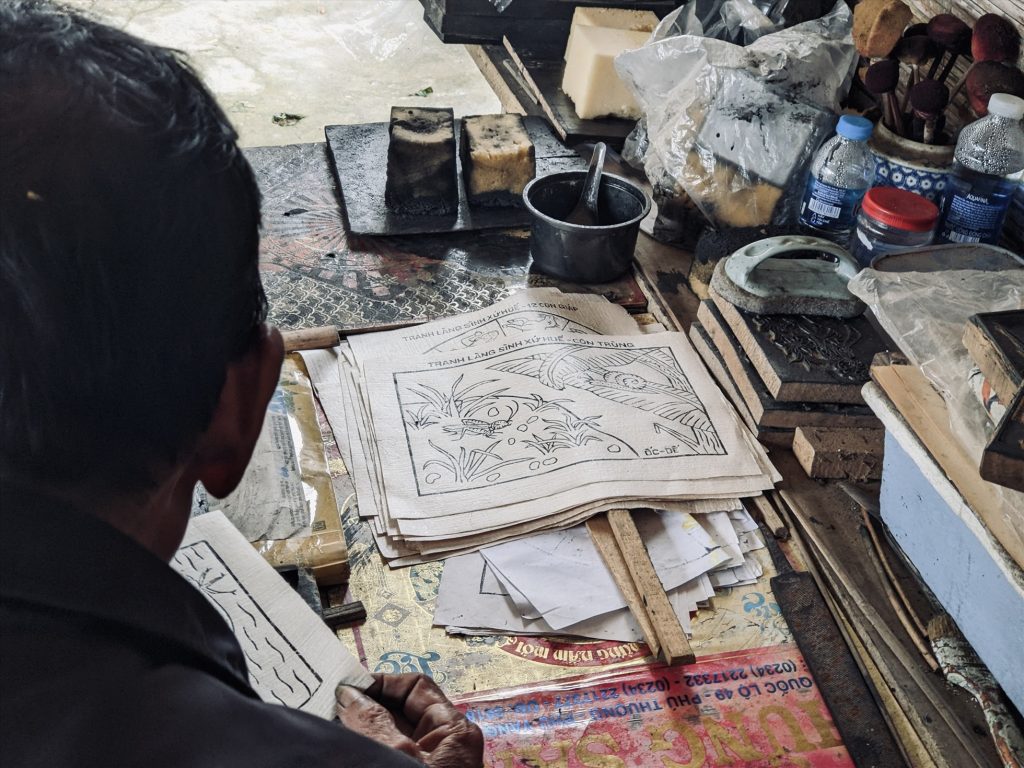
You will be guided by the artist on using black ink to apply to the canvas. Then, print it on paper. Let the painting dry. Finally, unleash your creativity and add colors to the painting. For international tourists and foreign visitors, this is the most fascinating experience they eagerly anticipate.
Participate in the lively festival in Sinh Hue village.
If you visit Sinh Hue village on the 10th day of the Lunar New Year, you will immerse yourself in the atmosphere of the village wrestling festival in Hue. At this time, the people of Phú Mậu commune beat drums and raise flags to celebrate the festival.
The Sình village wrestling festival in Hue has been a beautiful cultural tradition for over 400 years, since the time of the Nguyễn lords. The festival attracts a large number of tourists and local residents every year.
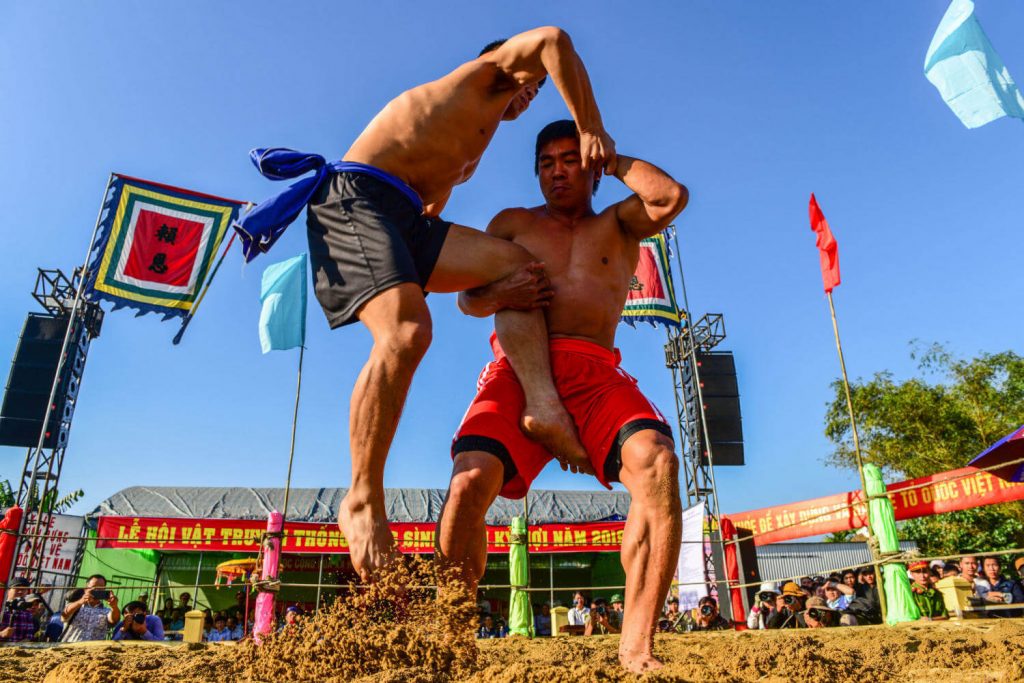
The festival is an occasion to promote the martial spirit, enhance physical fitness and sports training. Along with that, it helps to boost the bravery and intelligence of the strong young men of Sinh Hue village.
The Sình village wrestling festival in Hue usually takes place in one day and consists of a ceremony and a festival. It promises unforgettable experiences for visitors.
Purchase folk paintings from Sinh Hue village as gifts.
In addition to visiting the peaceful craft village located by the Huong River and admiring the paintings, observing the artists creating complete artworks, visitors to Sinh Hue village can also purchase paintings as gifts or for personal use.
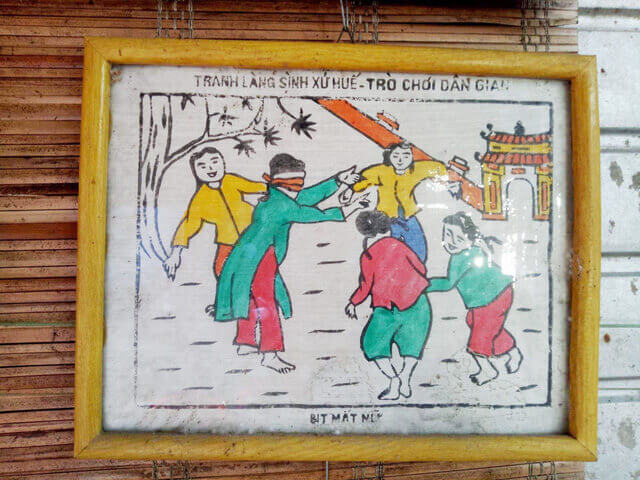
Although creating a painting requires many meticulous and elaborate stages, with each painting containing the dedication, time, and essence of the artist, Sinh Hue village paintings are reasonably priced.
The typical prices for each painting are as follows:
- Ancestor worship paintings: From 15,000 to 25,000 VND per painting.
- Decorative paintings: From 70,000 to 90,000 VND per painting.
Some notes when exploring Sinh Hue village.
Sình village is increasingly sought after by many tourists to learn about folk culture. Therefore, make sure to include this destination in your Hue trip. Before planning your trip, danangprivatecar.com would like to provide you with the following notes:
- Before packing your bags to visit Sinh Hue village, make sure not to overlook the step of preparing your luggage. This is an outdoor tourist destination, and you will move around quite a bit during the sightseeing process. Therefore, bring comfortable, soft, and sweat-absorbent clothing.
- As a place of cultural and historical significance, it is most appropriate to dress modestly and respectfully when visiting the painting village.
- Do not push or shove when visiting. Pay attention to preserving the cleanliness of the environment and landscape in the painting village.
- Do not move or touch any items in Sinh Hue village without permission, including the paintings and antiques.
The tourist area of Sinh Hue village offers many unique and unparalleled experiences for visitors. When you come to this rustic riverside village, you will discover the beauty of the cultural heritage of a traditional craft village. You can personally create a painting from a raw print that reflects your personal touch and indulge in the culinary paradise of the ancient capital. What could be more wonderful than that, right?

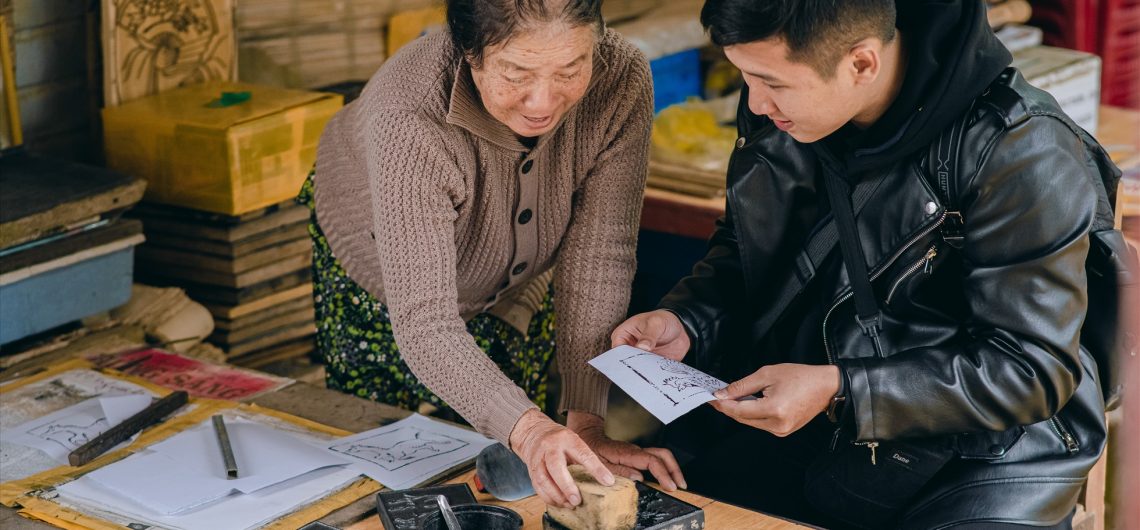
Comments